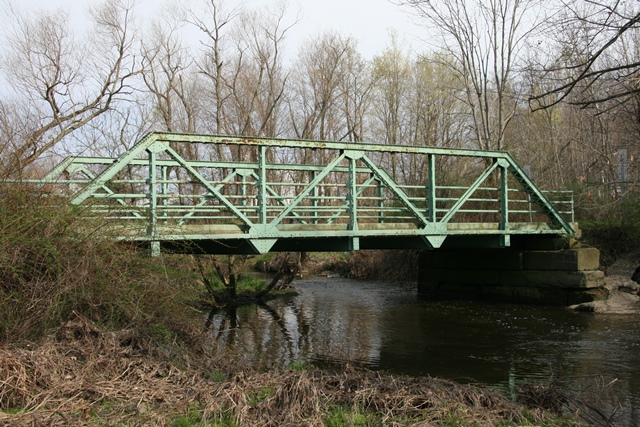We Recommend:
Bach Steel - Experts at historic truss bridge restoration.
BridgeHunter.com Phase 1 is released to the public! - Visit Now
Clay Road Bridge

Primary Photographer(s): Nathan Holth and Rick McOmber
Bridge Documented: June 30, 2006 and April 30, 2011
Rural: Ashtabula County, Ohio: United States
1919 By Builder/Contractor: Brookville Bridge Company of Brookville, Ohio
Not Available or Not Applicable
47.0 Feet (14.3 Meters)
50.0 Feet (15.2 Meters)
16 Feet (4.88 Meters)
1 Main Span(s)
432350

View Information About HSR Ratings
Bridge Documentation
View Archived National Bridge Inventory Report - Has Additional Details and Evaluation
This is a small Warren pony truss, that retains a high degree of historic integrity. The bridge retains original pole railings. The builder plaque remains on the bridge, crediting the Brookville Bridge Company with building the bridge in 1919. The deck is concrete. Connections on the bridge are riveted. Extensive v-lacing is on the bridge, present under the top chord / end posts, and on the verticals and diagonals. Steel on the bridge was fabricated by Cambria.
Information and Findings From Ohio's Historic Bridge InventorySetting/Context The bridge carries a 1 lane road over a stream in a sparsely developed, rural setting. Physical Description The 1 span, 50'-long rivet-connected Pratt pony truss bridge is composed of built-up members and has pipe railings. Summary of Significance The 1919 Pratt pony truss is a late example of its type/design with no distinguishing features. It has riveted connections, typical of Pratt trusses from about 1900 to the 1940s when riveted connections began to
be phased out in favor of welded connections. This example is not historically significant for its technology or context. More distinguished examples better represent the significance of the type/design in the development of the
state's road systems. Bridge Considered Historic By Survey: No |
This bridge is tagged with the following special condition(s): Unorganized Photos
![]()
Photo Galleries and Videos: Clay Road Bridge
2006 Bridge Photo-Documentation
Original / Full Size PhotosA collection of overview and detail photos. This gallery offers photos in the highest available resolution and file size in a touch-friendly popup viewer.
Alternatively, Browse Without Using Viewer
![]()
2006 Bridge Photo-Documentation
Mobile Optimized PhotosA collection of overview and detail photos. This gallery features data-friendly, fast-loading photos in a touch-friendly popup viewer.
Alternatively, Browse Without Using Viewer
![]()
2011 Additional Unorganized Photos
Original / Full Size PhotosA supplemental collection of photos that are from additional visit(s) to the bridge and have not been organized or captioned. This gallery offers photos in the highest available resolution and file size in a touch-friendly popup viewer.
Alternatively, Browse Without Using Viewer
![]()
2011 Additional Unorganized Photos
Mobile Optimized PhotosA supplemental collection of photos that are from additional visit(s) to the bridge and have not been organized or captioned. This gallery features data-friendly, fast-loading photos in a touch-friendly popup viewer.
Alternatively, Browse Without Using Viewer
![]()
Maps and Links: Clay Road Bridge
Coordinates (Latitude, Longitude):
Search For Additional Bridge Listings:
Bridgehunter.com: View listed bridges within 0.5 miles (0.8 kilometers) of this bridge.
Bridgehunter.com: View listed bridges within 10 miles (16 kilometers) of this bridge.
Additional Maps:
Google Streetview (If Available)
GeoHack (Additional Links and Coordinates)
Apple Maps (Via DuckDuckGo Search)
Apple Maps (Apple devices only)
Android: Open Location In Your Map or GPS App
Flickr Gallery (Find Nearby Photos)
Wikimedia Commons (Find Nearby Photos)
Directions Via Sygic For Android
Directions Via Sygic For iOS and Android Dolphin Browser
USGS National Map (United States Only)
Historical USGS Topo Maps (United States Only)
Historic Aerials (United States Only)
CalTopo Maps (United States Only)

